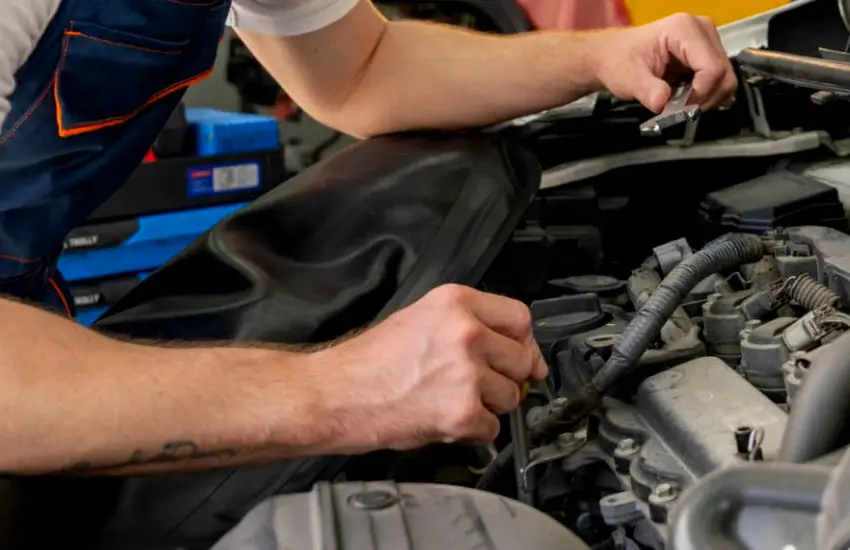As an Amazon Associate, I earn from qualifying purchases at no extra cost to you.
Weak Air Flow From Vents in Car: Causes and Solutions
Have you ever been driving on a hot day, eager to cool down your car, only to realize that the air blowing from your vents is weak and barely noticeable? If so, you’re not alone. Weak air flow from your car’s vents can be a frustrating issue, especially when you’re counting on your vehicle’s air conditioning or heating system to maintain comfort. Understanding the reasons behind weak air flow and how to fix it can help you enjoy a more comfortable ride, no matter the weather outside.
In this article, we will explore the common causes of weak air flow from vents in a car, discuss how these issues can affect the performance of your HVAC system, and provide practical solutions to fix the problem. Whether it's a simple clog or a more complex mechanical issue, we've got you covered. Let's dive into the world of car ventilation systems and uncover what might be causing your weak air flow.
Common Causes of Weak Air Flow
The first step in addressing weak air flow from the vents is understanding the potential causes behind it. There are several factors that could lead to a noticeable drop in air pressure or volume, and identifying the culprit is essential to fixing the problem.
1. Dirty Air Filters
One of the most common reasons for weak air flow in your car is a dirty or clogged cabin air filter. The air filter in your vehicle is designed to prevent dust, debris, and other particles from entering the cabin through the HVAC system. Over time, this filter can become clogged with dirt, reducing the amount of air that can pass through.
A clogged filter can not only reduce the flow of air but can also affect the efficiency of your air conditioning and heating system. When the filter is obstructed, it forces the system to work harder to push air through, which can lead to poor airflow and reduced performance.
2. Blocked Vents
Sometimes, the problem isn't with the HVAC system itself, but rather with the vents. If vents are blocked by objects, dirt, or debris, it can restrict air from flowing freely into the cabin. This can happen if you have loose items in your car that have ended up blocking the vents or if there's a buildup of dust and debris around the vent openings.
In some cases, the vents themselves might be misaligned or broken, which can cause weak or uneven airflow. Regular inspection and cleaning of your car's vents can help prevent this issue from becoming a problem.
3. Leaks in the Ductwork
Another potential issue that could lead to weak air flow is a leak in the car’s ductwork. Your vehicle's HVAC system relies on a series of ducts to direct air to different parts of the cabin. If these ducts become cracked, disconnected, or damaged, air may escape before it can reach the vents. This can result in a noticeable drop in air flow or uneven distribution of air throughout the cabin.
Ductwork leaks can be difficult to detect because they are often hidden under the dashboard or behind other components. However, if you notice a significant decrease in air pressure or a musty smell coming from the vents, it could indicate a problem with your car's ducts.
4. Faulty Blower Motor
The blower motor is responsible for pushing air through your car's HVAC system. If the blower motor is failing or not working properly, it can lead to weak air flow. In some cases, the motor may still be working but at a reduced speed, which can cause the air to feel weaker than usual.
A malfunctioning blower motor can be caused by a variety of issues, including electrical problems, a worn-out motor, or a faulty resistor. If the blower motor is the cause of the weak airflow, it may need to be repaired or replaced.
5. Low Refrigerant Level (for A/C)
If you're experiencing weak air flow specifically from your car's air conditioning system, a low refrigerant level could be the culprit. The refrigerant in your A/C system is responsible for cooling the air before it's blown into the cabin. If the refrigerant level is low due to a leak or other issue, the air coming from the vents may feel weak and not cool effectively.
A low refrigerant level can also cause the A/C system to strain, leading to further issues and a reduced lifespan for the components. If you suspect your refrigerant level is low, it's essential to have it checked by a professional to avoid further damage to the system.
6. Problems with the Heater Core (for Heating Issues)
If you're experiencing weak air flow in your car's heating system, a problem with the heater core could be to blame. The heater core is responsible for transferring heat from the engine coolant to the air that's blown into the cabin. If the heater core is clogged or malfunctioning, it can cause weak air flow and ineffective heating.
A clogged heater core can be caused by a buildup of debris or rust inside the core, restricting the flow of coolant and preventing the system from producing sufficient heat. If this is the issue, the heater core may need to be flushed or replaced.
How to Fix Weak Air Flow in Car Vents
Now that we've covered some of the most common causes of weak air flow, let's talk about how you can fix the issue. Depending on the cause, some solutions may be quick and easy, while others may require professional help.

1. Replace or Clean the Cabin Air Filter
If a dirty cabin air filter is the cause of weak air flow, the solution is simple: replace or clean the filter. Most car manufacturers recommend replacing the cabin air filter every 12,000 to 15,000 miles, but if you live in an area with a lot of dust or pollen, you may need to replace it more often.
Cleaning the filter can sometimes be a temporary solution, but replacing it is the most effective way to restore proper air flow. Cabin air filters are typically easy to access and replace, and they are relatively inexpensive.
2. Clean or Unblock the Vents
To fix blocked or obstructed vents, you should first inspect the vents for any visible blockages. This may include items such as tissues, wrappers, or other debris that could be obstructing the airflow. Once you've cleared any debris, clean the vent openings using a soft cloth or brush to remove dust and dirt buildup.
If you notice that the vents themselves are misaligned or broken, it may be necessary to replace them. This is usually a straightforward task, but you may want to consult a mechanic if you're unsure how to proceed.
3. Inspect and Repair the Ductwork
If you suspect that your car's ductwork is leaking or damaged, you'll need to have it inspected by a professional. This is a more complicated issue, as the ducts are often hidden behind panels and require special tools to access. A mechanic can inspect the ducts for leaks and either repair or replace the affected sections.
If the problem is with the seals around the ducts, these can often be replaced without replacing the entire ductwork. In either case, repairing leaks in the ductwork can restore proper air flow to your vents.
4. Replace the Blower Motor
If the blower motor is the cause of the weak air flow, it may need to be repaired or replaced. Depending on the severity of the issue, you may hear strange noises coming from the motor, or it may not work at all. If the motor is still working but at a reduced speed, the resistor or electrical connections may need attention.
Replacing the blower motor is a more advanced repair that may require the help of a professional mechanic. This is particularly true if the motor is located in a difficult-to-reach area, such as beneath the dashboard.
5. Refill or Replace the Refrigerant
For weak air flow related to your car's air conditioning, a low refrigerant level could be the issue. To fix this, you'll need to have the refrigerant level checked and refilled if necessary. This is not a job you can typically do yourself, as it requires specialized equipment and knowledge to ensure the system is properly recharged.
If the refrigerant is low due to a leak, the leak will need to be located and repaired before the system can be refilled. A professional A/C technician can perform these checks and repairs to restore your A/C system to full functionality.
6. Flush or Replace the Heater Core
If the issue lies with the heater core, the solution may involve flushing the core to remove any debris or buildup. In more severe cases, the heater core may need to be replaced entirely. Flushing the heater core can help restore normal airflow and heating performance, while replacing it is a more involved repair that may require the removal of other components.
This is a repair best left to professionals, as it can be complicated and may involve the draining of the coolant system.
I hope this article has given you a clearer understanding of the reasons why weak air flow from the vents in your car can occur and how to address the issue. Whether it's something simple like a clogged filter or a more complex problem with the HVAC system, there are solutions available to help restore comfort and efficiency to your car's climate control system.
Also Read: How To Keep A Black Car Clean
Are These Questions in Your Mind?
Is it normal to have weak air flow in my car?
Weak airflow can be caused by a variety of factors, but it is not something that should be considered normal. It typically indicates an issue that needs to be addressed.
Can a dirty air filter cause weak air flow?
Yes, a dirty or clogged air filter is one of the most common causes of weak airflow. Replacing the cabin air filter is an easy fix to restore proper airflow.
Do I need to replace the cabin air filter regularly?
Yes, it is recommended to replace the cabin air filter every 12,000 to 15,000 miles or once a year, depending on driving conditions.
Is it safe to drive with weak air flow from the vents?
While it's generally safe to drive with weak airflow, it can be uncomfortable and may indicate an issue that should be addressed to avoid further problems with the HVAC system.
Can a low refrigerant level cause weak air flow in the car?
Yes, low refrigerant levels can affect the performance of your car's air conditioning system, causing weak airflow.
Do I need professional help if my blower motor is faulty?
If the blower motor is faulty, it's often best to seek professional assistance to replace or repair the motor.
Can a blocked air duct be cleaned easily?
Some blockages can be cleared with a vacuum or compressed air, but if the duct is damaged or heavily clogged, it may require professional repair.
Is it possible to fix weak airflow without replacing parts?
In some cases, cleaning or repairing existing components, like the blower motor or air ducts, can help improve airflow without the need for replacement parts.
Do I have to replace the heater core or evaporator if they are faulty?
Faulty heater cores or evaporators often need to be replaced, but these repairs are more complex and typically require professional help.
Can I check my car's HVAC system myself for weak airflow?
You can inspect basic components like the air filter, blower motor, and air ducts, but more complex issues may require professional diagnostics and repair.











